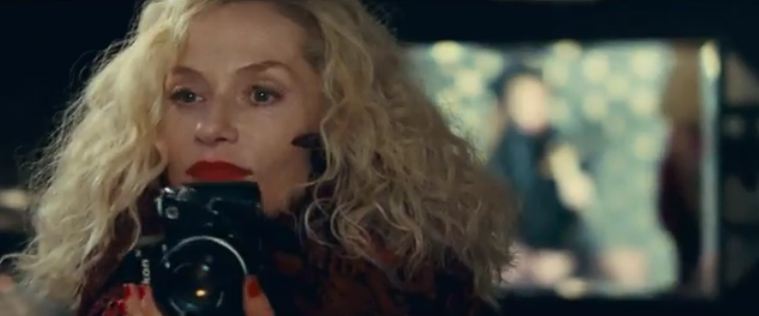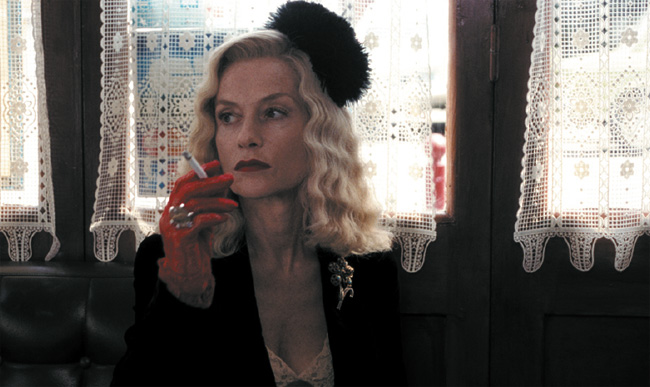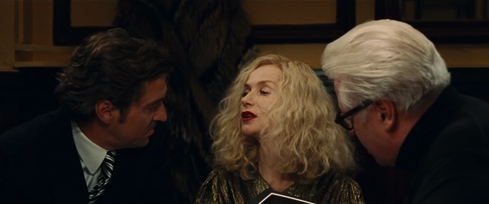When it was announced that Eva Ionesco had written a script based upon her childhood and that she had secured Isabelle Huppert, one of the most brilliant film actors working, to star in a film Eva would direct I was quite excited. As the film industry grapples stupidly with ever-changing demands of media access, many films are getting lost in the shuffle. Eva Ionesco’s movie, My Little Princess is one of those films. Whether it was due to the subject matter, the film’s original title (I’m No Fucking Little Princess), or a perceived lack of Hollywood ‘Star Power’ — the film has yet to be picked up for US/Canadian distribution. This means that Ionesco’s film remains a curiosity for many viewers. However, if you’ve a region-free DVD player the film can be viewed right now via the UK distribution DVD.
One can only imagine the psychological tight rope that Eva Ionesco was walking as she wrote and then filmed her version of her infamous childhood. In the event that you are not aware, Eva Ionesco’s mother became a highly acclaimed and often ridiculed photographer thanks to using Eva as the model for many of her early photographs in the early 70’s. The photographs remain controversial and debated today. The images Irina Ionesco choose to create with her daughter as a model are artistic – – possibly even poetic. However, most of the images push past what most of us would consider acceptable boundaries in the photographing of a child. Irina choose to have Eva nude and posed in sexually provocative ways. Most controversially, she allowed Penthouse Magazine to photograph Eva in a questionable manner. Because of the artistry involved in Irina’s work, she somehow managed to avoid legal persecution at the time. Of course, it was the 70’s. If ever there was a decade fueled by sexual/political confusion it was that time period. All the same, Irina and Eva Ionesco were for a brief time the darlings of the Art World. Irina’s work would go on to inspire Brooke Shield’s mother to have her daughter pose in radically controversial photographs and featured nude in the film, Pretty Baby. The difference between the photographs and work done with Brooke Shields was that it managed to never totally cross that line into pornography. Irina Ionesco’s work often seems to trip past the line into what some could easily call illegal pornography. Eva Ionesco, now well into her 40’s has never really publicly stated the impact of this time in her life. …Until now.

Isabelle Huppert and Anamaria Vartolomei as Mother/Photographer and Daughter/Model in My Little Princess. Promotional Photograph.
The challenge My Little Princess faces is the ultimate biography film conundrum: how does the director make a film about the exploitation of a child without exploiting the child playing the part? As writer/director, Eva Ionesco resolves this challenge by using dialog which discusses the graphic nature of the poses and photograph while limiting what the audience sees to uncomfortable shots of the young actor posed seductively minus any nudity or extreme costumery. This approach might have worked if Eva Ionesco had been able to tackle the difficult subject matter in a more even way.
Eva Ionesco changes the names, but this is clearly a film about she and her mother. Eva is called Violetta and Irina has become Hanna. From the moment the movie introduces us to Violetta’s mother, Hanna, it is all-too-clear that the daughter is viewed as a bother to the mother. Hanna breezes in and out of Violetta’s life like an almost comical storm of irrational emotion. Violetta has been raised by her Italian immigrant grandmother who is presented to us flatly. The character of the grandmother is no more than a prop in the film: overtly religious, doddering old lady full of superstitions. Hanna, portrayed problematically by Isabelle Huppert, is presented as shallow, tyrannical, confused, irrational, lofty, gothic, death-obssessed and narcissistic — all of these traits to the point of dark comedy. Little Violetta is presented as a sweet little girl who turns equally sour and confused as the story progresses. Hanna is given a camera by her “sort of lover” and somewhat successful painter male friend. She then discovers her true calling as a photographer. Suddenly she no longer sees her daughter as bothersome “thing” but as a beautiful model for odd and gothic concepts. And, Violetta feels the possibility of love from her mother. Hanna’s photographs of Violetta become the talk of Paris. With each photo session we come to understand that Hanna pushes Violetta to pose further and further into the realm of the unacceptable.
We know things are headed in a very twisted route when Hanna provides her daughter with direction as she photographs her:
“Do not smile! That is for the stupid and weddings!” and the even more telling instruction, “Look up into my eyes as if you are looking into the face of Hell.”
Clothed and veiled in out-dated adult clothing and adult women’s underwear, Violetta poses at first with flowers, then religious iconography to creepy child mannequins — and, then, we are told with skeletons and ultimately nude. Though, to her credit, Eva Ionesco avoids allowing the audience to actually see the truly controversial poses. At the same time, she fails to avoid levels of exploitation with her child actress by having her act in situations that most definitely push the cinematic envelope: other adult women take her place with nudity and discussion, Hanna thinks nothing of ripping her Violetta’s normal child clothing off of her in front of her classmates in the school lobby and replace them with an odd goth-like doll dress. Hanna also instructs Violetta to dress as a “woman” — which amounts to a child in slutty clothing that gets her a fair amount of jeers from other kids and disapproving reproaches from her teachers.
It isn’t long before Hanna makes Violetta feel that they are equals in her enterprise. She takes her everywhere with her as if they are not only co-artistes of the highest order but stylish women on the town. Before long Hana actually is the talk of Paris and the money is pouring in. Grandma is ever suspect, but happy to take the money.

Anamaria Vartolomei and Isabelle Huppert walking Eva Ionesco’s cinematic tight rope in My Little Princess
Soon, a trip is taken to England where Hanna has been commissioned to photograph a rock star of the era. She entices Violetta into the trip by promising her a chance to see The Sex Pistols perform. Uh, oh. In an interesting casting choice, Jethro Cave plays the rock star. There is no ambiguity in Ionesco’s filmmaking during Hanna and Violettas’ stay in the rock stars mansion: Hanna is not above prostituting her daughter to the rock star for the job of photographing him.
While the characters move in a suddle way and nothing is filmed in an unacceptable way, Eva Ionesco somehow manages to make the audience feel as if she is hitting us on the head with a hammer: Hanna is using Violetta and Violetta knows it. During their stay in England, Violetta is introduced to drugs and off-screen seduced by the rock star. Violetta’s grandmother dies and the mother/daughter relationship becomes even more complicated and confused.
Hana finally pushes her “art” too far and the French Social Services get involved. Violetta starts to rebel against not only her mother but against all authority. Hana is faced with losing custody of Violetta.
Eva Ionesco has crafted the sort of movie that falls into what I would call a sort of cinematic train wreck that is hard to not watch. Obviously, Ionesco has inherited some of her mother’s gifts for photography. My Little Princess is a beautiful looking film. The use of light, dark, color and composition is exceptional in almost every shot.
The saddest thing about Eva Ionesco’s film is the waste of Isabelle Huppert. When the production of this film was announced Isabelle Huppert made it clear that she was thrilled to tackle a role inspired by Irina Ionesco. However, since the film was released, Huppert has stated that in all her years as an actor she had never experienced a more challenging and peculiar situation that filming My Little Princes. If one is to believe the press, Huppert has said that she knew she would need to act as a mother to Anamaria Vartolomei who was only ten years old when the movie was shot. She also knew that she would be playing Eva’s real life mother to a certain degree, but she was thrown off by the fact that she felt as if Eva Ionesco was actually projecting on to Isabelle Huppert to such a degree that she was playing “mom” both in front and well behind the camera. Huppert has also reportedly marked her concern that she is a good ten years too old for the role and there was nothing in the Ionesco’s script to explain this challenge.
As a viewer one can almost sense Huppert’s discomfort at times. Isabelle Huppert is an infinitely talented screen actress who has always seemed to run toward the most challenging, transgressive and unlikeable characters. She has never failed to infuse the characters she plays with a reality that very few actresses would be brave or talented enough to even try to play. If there is any actresses who come close it would be Tilda Swinton, Michelle Williams or Samantha Morton. Huppert is certainly not aided in her role by the rather schizophrenic screenplay. For the first half of the film it feels as if Isabelle Huppert is channeling Jennifer Saunders from AbFabas her character is presented to us a sort of idiotic boob who thrashes her body about in boredom or frustration. And, Eva Ionesco has written Hana to be totally unaware of the reactions of others to her odd antics. “Oh, don’t worry. They are just yokels!” Hana instructs her daughter as people stare.
And, to be honest, Huppert’s almost comic turn in the first half of the movie almost serves her scenes well. With mood swings presented in this manner it is most likely best to eat a bit of the scenery as you go along. Even still, Huppert does manage to find some powerful moments in My Little Princess.
There three key scenes that should offer the audience some insight into what must be a damaged soul of a human to take such unethical and immoral turns with her daughter. In one scene Hana makes an interesting observation about herself to Violetta: she tells her daughter that she suffers from a condition involving repulsion of the flesh. Huppert starts this scene on a roll only to be de-railed by Ionesco’s quick diversion away from the topic. That diversion is so thudding that Huppert’s brief first moment is turned into some sort of misplaced satire. Later, Hana strolls through a Parisian cemetery from which she has a perfect view from her apartment/studio. Huppert plays this scene with sly delicacy as she lays herself over a catacomb. This moment is killed by Bertrand Burgalat’s unfortunately heavy-handed musical score that would have better suited a 1940’s melodrama. The third, and what should have been the most important scene for Hanna, involves Hanna confessing to her now tainted and confused daughter, that her mother is the product of an incestuous relationship. Isabelle Huppert delivers this scene in a tender and exceptionally effective way only to be plundered by the reaction of her Violetta who delivers the last line of an old joke and “yuck”s herself away from Hanna. The viewer is left wondering if this is meant as some sort of sick joke. Left alone on screen, Huppert almost seems to be saying the same thing with her teared eyes.
And, of course the ultimate gut punch swing Eva Ionesco seems to take at her mother feels the most untrue. While I doubt there are very few people who would really and seriously argue that Irina Ionesco went to the point of child abuse in her photography of her child, I also doubt that anyone would dare to argue that Irina Ionesco is not a gifted photographer. She is especially brilliant in her self-portraits. So, it seems totally unbelievable when Eva Ionesco presents Hana making self-indulgent self-portraits like this one:
While the few poses and photographs Eva Ionesco re-creates for the camera work, this one fails. I am not trying to at all defend Irina Ionesco, but the artist would never take a photograph as lame as this one.
As Isabelle Huppert does her best to keep the film above the mess that is somehow is, Anamaria Vartolomei makes her screen debut at the age of only ten playing Violetta.
Vartolomei is amazing. Her performance is far deeper than any seen by such a young actor since Jodie Foster. Even when given ridiculous lines, Vartolomei delivers them in a believable manner. And, she also manages to somehow convey the joy of being admired and the repulsion of feeling exploited. Sadly, there is no exposition to explain how Vartolomei’s character is able to conclude that what her mother is having her do is wrong. We are just expected to know that this child knows it is wrong. …All of the sudden. …Out of the blue. …Little Violetta realizes that her modeling borderlines toward pornography. In moments of tantrums she convincingly says things like, “No! A party is a whore like art!” or “You are using me!” and the oddly blunt for a young child: “I’m your meal ticket!” Even still, Anamaria Vartolomei shines as Violetta. Aside from being astoundingly pretty she also manages to be a little girl playing “dress up” for her mother so convincingly that despite the fact that Ionesco goes to great pains to avoid exploiting the young actress — she carries herself believable as an abused child.
In the end, My Little Princess well outstays its welcome. At 135 minutes, it is far too long. And, the film itself has more mood swings than that of the character played by Isabelle Huppert. Perhaps the main problem with My Little Princess is that the film’s maker is just too intimate with the subject matter. It is almost as if an only half-healed victim of child abuse is attempting to tell her story — and the result is an uneven, schizophrenic and confused mess of a movie. My Little Princess is a cinematic error that almost errs enough to make it enjoyable. Fans of Isabelle Huppert, interesting cinematography or the whole Irina/Eva Ionesco history will ultimately be the only somewhat satisfied audience members.
As the credits rolled all I could think was how sad it was to see an actor of Isabelle Huppert’s stature failed so miserably by a director. On the bright side, there are more than a few things about this film that do work. Eva Ionesco has a keen eye and there does seem a great deal of potential here. Perhaps Eva Ionesco will get another opportunity and make a film fitting of her style. One thing is for certain: Anamaria Vartolomei looks to have a very bright future as an actress. And, if Isabelle Huppert can survive Heaven’s Gate – which she most certainly did – this film will not derail her.
But one thing will stick with you if you choose to see this movie:
There is nothing quite like hearing Isabelle Huppert advise, “Look up into my eyes as if you are looking into the face of Hell.”
MY LITTLE PRINCESS
Eva Ionesco, 2011

















